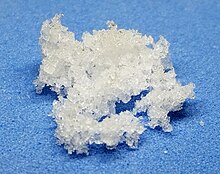Chemistry:1,9-Nonanediol
From HandWiki

| |
| Names | |
|---|---|
| Preferred IUPAC name
1,9-Nonanediol | |
| Other names
1,9-Dihydroxynonane
| |
| Identifiers | |
3D model (JSmol)
|
|
| ChEBI | |
| ChemSpider | |
| EC Number |
|
PubChem CID
|
|
| UNII | |
| |
| |
| Properties | |
| C9H20O2 | |
| Molar mass | 160.25 g/mol |
| Appearance | White solid |
| Melting point | 46.4 °C (115.5 °F; 319.5 K)[1] |
| Boiling point | 173 °C (343 °F; 446 K) at 20 mmHg |
| Thermochemistry[2] | |
Std enthalpy of
formation (ΔfH⦵298) |
-657.6 kJ/mol |
Except where otherwise noted, data are given for materials in their standard state (at 25 °C [77 °F], 100 kPa). | |
| Infobox references | |
1,9-Nonanediol, also known as nonamethylene glycol, is a diol with the molecular formula HO(CH2)9OH. It is a colorless solid, which is sparingly soluble in water but readily soluble in ethanol.[1]
1,9-nonanediol can be produced by isomerization of allyl alcohol.[3] It can also be obtained by reacting methyl oleate with triethylsilyl hydrotrioxide and lithium aluminum hydride.[4]
1,9-Nonanediol is used as a monomer in the synthesis of some polymers. It is also used as an intermediate in the manufacturing of aromatic chemicals and in the pharmaceutical industry.
See also
References
- ↑ 1.0 1.1 Haynes, William M., ed (2016). CRC Handbook of Chemistry and Physics (97th ed.). CRC Press. p. 3.420. ISBN 9781498754293.
- ↑ Haynes, William M., ed (2016). CRC Handbook of Chemistry and Physics (97th ed.). CRC Press. p. 5.30. ISBN 9781498754293.
- ↑ Tsuji, J. (2002). Transition Metal Reagents and Catalysts: Innovations in Organic Synthesis. Wiley. p. 183. ISBN 978-0-471-56027-2.
- ↑ Fuchs, P.L. (2011). Reagents for Silicon-Mediated Organic Synthesis. Handbook of Reagents for Organic Synthesis. Wiley. p. 514. ISBN 978-0-470-71023-4.
 |

